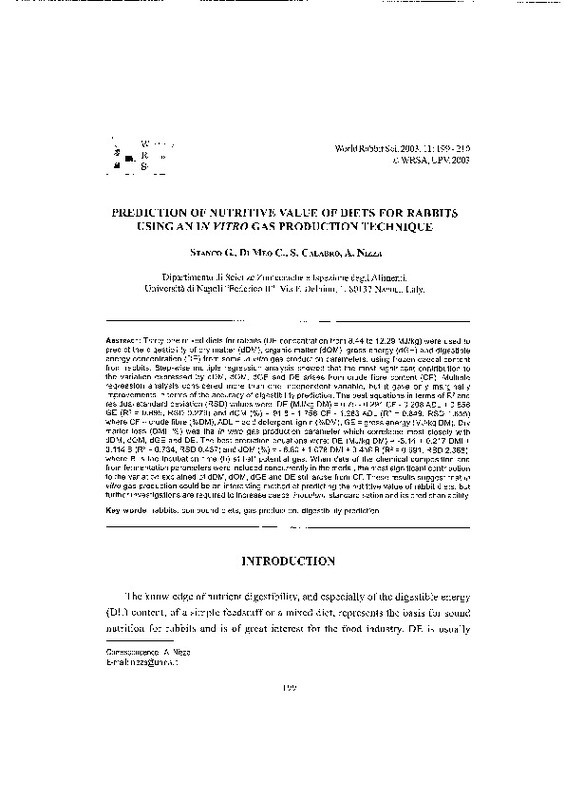JavaScript is disabled for your browser. Some features of this site may not work without it.
Buscar en RiuNet
Listar
Mi cuenta
Estadísticas
Ayuda RiuNet
Admin. UPV
PREDICTION OF NUTRITIVE VALUE OF DIETS FOR RABBITS USING AN IN VITRO GAS PRODUCTION TECHNIQUE
Mostrar el registro sencillo del ítem
Ficheros en el ítem
| dc.contributor.author | Stanco, G.
|
|
| dc.contributor.author | Di Meo, C.
|
|
| dc.contributor.author | Calabrò, C.
|
|
| dc.contributor.author | Nizza, A.
|
|
| dc.date.accessioned | 2011-02-23T08:24:38Z | |
| dc.date.available | 2011-02-23T08:24:38Z | |
| dc.date.issued | 2003 | |
| dc.identifier.issn | 1257-5011 | |
| dc.identifier.uri | http://hdl.handle.net/10251/9935 | |
| dc.description.abstract | [EN] Thirty-one mixed diets for rabbits (DE concentration from 8.44 to 12.29 MJ/kg) were used to predict the digestibility of dry matter (dDM), organic matter (dOM), gross energy (dGE) and digestible energy concentration (DE) from some in vitro gas production parameters, using frozen caecal content from rabbits. Step-wise multiple regression analysis showed that the most significant contribution to the variation expressed by dDM, dOM, dGE and DE arises from crude fibre content (CF). Multiple regression analysis considered more than one independent variable, but it gave only marginally improvements in terms of the accuracy of digestibility prediction. The best equations in terms of R2 and residual standard deviation (RSD) values were: DE (MJ/kg DM) = 0.75 - 0.291 CF - 0.208 ADL + 0.856 GE (R2 = 0.895, RSD 0.279) and dOM (%) = 91.8 - 1.756 CF - 1.283 ADL (R2 = 0.849, RSD 1.655) where CF = crude fibre (%DM), ADL = acid detergent lignin (%DM), GE = gross energy (MJ/kg DM). Dry matter loss (DMl, %) was the in vitro gas production parameter which correlated most closely with dDM, dOM, dGE and DE. The best prediction equations were: DE (MJ/kg DM) = -3.14 + 0.217 DMl + 0.114 B (R2 = 0.734, RSD 0.437) and dOM (%) = - 6.80 + 1.078 DMl + 0.456 B (R2 = 0.691, RSD 2.368), where B is the incubation time (h) at half potential gas. When data of the chemical composition and from fermentation parameters were included concurrently in the model, the most significant contribution to the variation explained of dDM, dOM, dGE and DE still arose from CF. These results suggest that in vitro gas production could be an interesting method of predicting the nutritive value of rabbit diets, but further investigations are required to increase caecal inoculum standardisation and its prediction ability. | es_ES |
| dc.language | Inglés | es_ES |
| dc.publisher | World Rabbit Science. ICTA. UPV | es_ES |
| dc.relation.ispartof | World Rabbit Science | |
| dc.rights | Reserva de todos los derechos | es_ES |
| dc.subject | Rabbits | es_ES |
| dc.subject | Compound diets | es_ES |
| dc.subject | Gas production | es_ES |
| dc.subject | Digestibility prediction | es_ES |
| dc.title | PREDICTION OF NUTRITIVE VALUE OF DIETS FOR RABBITS USING AN IN VITRO GAS PRODUCTION TECHNIQUE | es_ES |
| dc.type | Artículo | es_ES |
| dc.date.updated | 2011-02-23T08:12:33Z | |
| dc.identifier.doi | 10.4995/wrs.2003.508 | |
| dc.rights.accessRights | Abierto | es_ES |
| dc.description.bibliographicCitation | Stanco, G.; Di Meo, C.; Calabrò, C.; Nizza, A. (2003). PREDICTION OF NUTRITIVE VALUE OF DIETS FOR RABBITS USING AN IN VITRO GAS PRODUCTION TECHNIQUE. World Rabbit Science. 11(4):199-210. https://doi.org/10.4995/wrs.2003.508 | es_ES |
| dc.description.accrualMethod | SWORD | es_ES |
| dc.relation.publisherversion | https://doi.org/10.4995/wrs.2003.508 | |
| dc.description.upvformatpinicio | 199 | |
| dc.description.upvformatpfin | 210 | |
| dc.description.volume | 11 | |
| dc.description.issue | 4 | |
| dc.identifier.eissn | 1989-8886 | es_ES |








